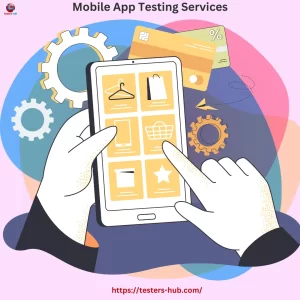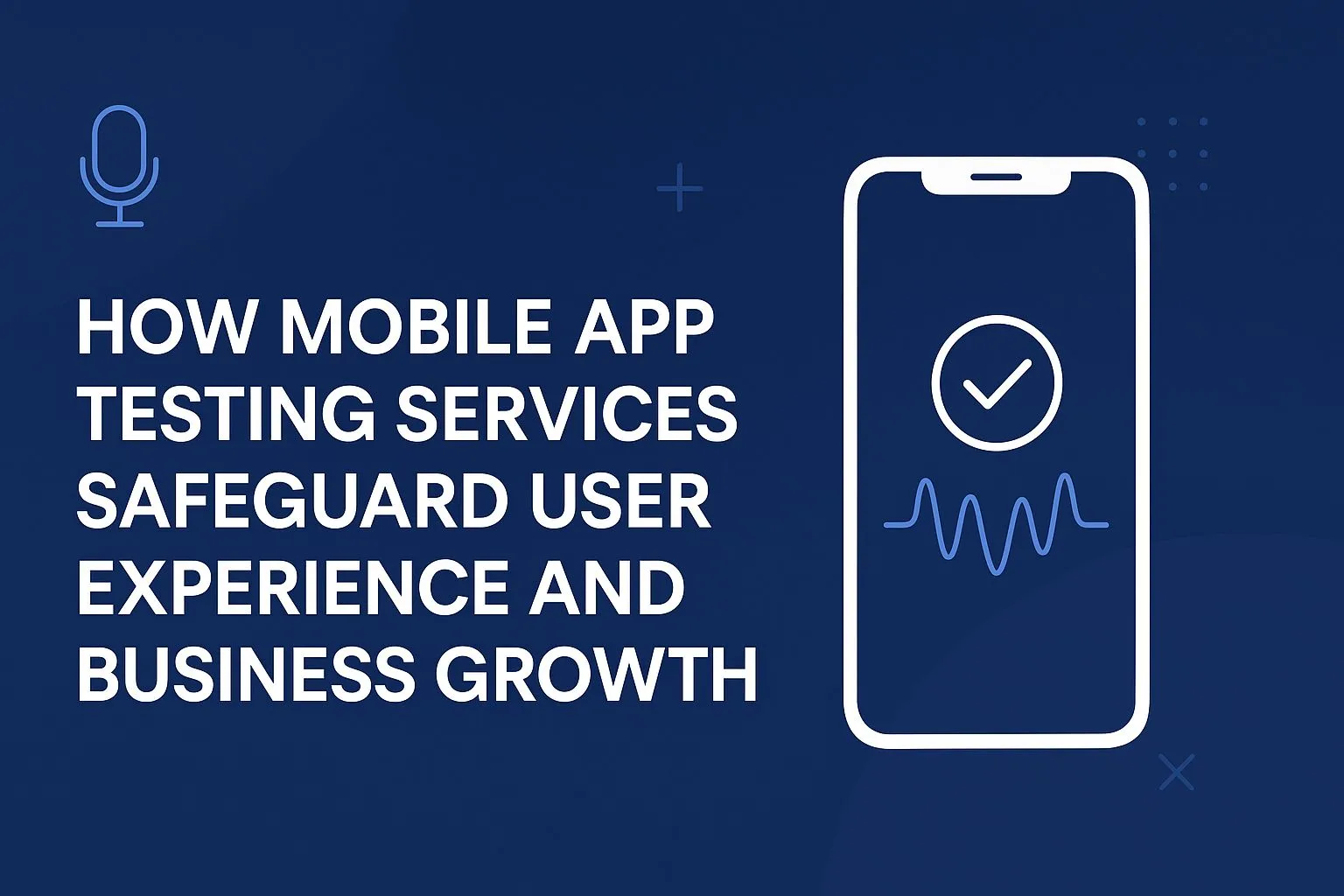How to Write Effective Test Cases for Mobile App Testing Services
Introduction
In today’s fast-paced mobile world, where businesses are increasingly reliant on apps to meet customer demands, ensuring high-quality mobile applications is critical to success. With the sheer number of apps released daily, delivering a flawless user experience, reliable functionality, and top-notch performance is essential to keeping users engaged and avoiding negative feedback.
This is where mobile app testing services become indispensable. Testing ensures that mobile apps not only function correctly but also offer a smooth and consistent experience across various devices, operating systems, and screen sizes. One of the key components of an effective testing strategy is creating well-structured test cases.
Test cases serve as the blueprint for testers, guiding them through the process of evaluating an app’s functionality, usability, and performance. Properly written test cases help ensure that all features of the app are thoroughly tested under a variety of conditions, which leads to a more robust and user-friendly final product. In this blog, we’ll explore how to craft effective test cases for mobile app testing services and explain why this practice is so essential to delivering a high-quality app experience.
Importance of Well-Written Test Cases in Mobile App Testing Services
In the domain of mobile app testing services, test cases are vital tools that go beyond just listing items to be tested; they are strategic resources that help testers navigate the application’s features and functionality effectively. The quality of test cases significantly influences the success of the testing process, offering several key advantages:
Promote Clarity and Consistency:
A well-formulated test case ensures that all testers—regardless of their level of experience or location—understand the required steps and expected outcomes. This consistency is especially important when tests are conducted on different devices and platforms, as it aligns everyone’s understanding.
Enable Reproduction of Issues:
When defects are discovered, it’s crucial for developers and testers to replicate the issues accurately. Test cases document the precise steps and conditions needed to reproduce a bug, facilitating effective troubleshooting and resolution.
Increase Efficiency:
Comprehensive allow testers to follow a systematic approach to testing, minimizing the risk of random or unstructured testing methods. This organized strategy helps optimize time and resources, which is particularly important for extensive mobile app testing initiatives.
Ensure Thorough Coverage:
By linking test cases to functional requirements, testers ensure that they examine all essential features. This structured approach helps them address every aspect of the application, including various workflows and edge cases.
Support Ongoing Regression Testing:
As mobile applications receive updates, having a well-organized library of test cases enables testers to quickly verify that new changes have not unintentionally caused defects in other parts of the app. This ongoing diligence is crucial for maintaining the overall quality of the application over time.
With these benefits in mind, it’s clear that carefully structured test cases are integral to successful mobile app testing services. But what are the key elements that make up a well-designed test case? Let’s explore the fundamental components.
Components of a Test Case in Mobile App Testing Services
Test Case ID:
This serves as a unique identifier for each test case, facilitating tracking and reference when issues arise or when tests need to be repeated. Organizing test case IDs in a systematic manner is advisable, as it allows testers to quickly find the relevant cases.
Test Description:
This section provides a concise overview of what the test case is intended to assess. It helps testers grasp the specific functionality or feature being tested. For instance, a description like “Verify login functionality with valid user credentials” clearly indicates what aspect of the app is under evaluation.
Preconditions:
Preconditions specify the requirements that testers must satisfy before executing the test case. In the context of mobile applications, this might include logging into an account, ensuring a stable internet connection, or granting the necessary app permissions.
Test Steps:
This component details the specific actions that testers need to carry out to perform the test. The steps should be articulated in a clear and concise manner, ensuring they are easy to follow. For example, in mobile app testing, the steps could include launching the app, navigating to particular features, or interacting with UI elements.
Expected Results:
This section describes the anticipated outcomes following the execution of the test steps. It plays a vital role in assessing whether the test passes or fails. For example, an expected result might state, “The user should successfully navigate to the home screen upon logging in.”
Actual Results:
During the testing phase, testers record the actual behavior of the app after executing the test steps. If they find discrepancies between the actual and expected results, they mark the test case as failed and initiate further investigation into the issue.
Step-by-Step Guide to Writing Test Cases for Mobile App Testing Services
Now that we’ve covered the essential components of a test case, let’s explore a detailed, step-by-step guide for writing effective test cases tailored specifically for mobile app testing services.
1. Comprehend the Requirements
The first step in crafting test cases is to thoroughly understand the app’s requirements. This encompasses both functional and non-functional aspects. Functional requirements detail what the app is supposed to do, while non-functional requirements focus on performance, usability, and other quality attributes.
Engage with developers, product managers, and stakeholders to gather insights about how the application should operate, the intended user base, and the devices on which it will be used.
For instance, when testing an e-commerce application, it’s vital to map out key user interactions, such as browsing products, adding items to a shopping cart, and completing a purchase transaction. Additionally, consider various factors like screen resolutions, operating systems, and network conditions that could impact the app’s performance and user experience. Understanding these requirements will lay a solid foundation for developing comprehensive test cases that effectively evaluate the app’s functionality.
2. Identify Test Scenarios
Once you understand the requirements, the next step is to identify the test scenarios. A test scenario is essentially a high-level test that describes what functionality or feature you are going to test. Mobile apps often have multiple user flows, and each of these flows will need to be tested thoroughly.
For example, in a ride-sharing app, some test scenarios might include:
- Testing user registration and login.
- Verifying the app’s ability to search for and display nearby drivers.
- Confirming that users can successfully book and cancel rides.
Test scenarios should cover both common user actions and edge cases to ensure the app works correctly under various conditions.
3. Write Clear and Concise Test Steps
Now that you’ve identified your test scenarios, you can begin drafting the test steps. Test steps need to be written in a way that any tester can follow, even if they are unfamiliar with the app. Each step should be action-oriented and specific.
Here’s an example of how to write test steps for a simple login scenario:
- Launch the mobile app.
- Tap on the “Login” button.
- Enter valid credentials (e.g., email and password).
- Tap on the “Submit” button.
This clarity and precision allow testers to execute the steps without confusion, reducing the chances of error and ensuring the app is thoroughly tested.
4. Define Expected Outcomes
Once the test steps are defined, the next crucial step is to document the expected outcome of each action. This helps the tester determine whether the app is behaving as it should.
Continuing with the login example, an expected outcome could be:
- “The user should be directed to the dashboard after entering valid credentials.”
Clear expected outcomes make it easier to identify when the app deviates from its intended behavior.
5. Review and Revise
After writing your test cases, it’s important to review them. Collaborate with your team to ensure that the test cases are complete, clear, and cover all relevant scenarios. During this review process, testers, developers, and product managers can provide valuable feedback to improve the test cases.
Revise the test cases based on this feedback, ensuring that they are aligned with the app’s current features and any recent changes in requirements.
Best Practices for Writing Test Cases for Mobile App Testing Services
To make sure your test cases are as effective as possible, it’s important to follow certain best practices. These will help streamline the testing process and ensure that the test cases are useful across different testing phases and team members.
- Use Consistent Formatting: A standardized format makes test cases easier to read, follow, and maintain. Whether you’re testing on Android, iOS, or across multiple devices, consistent formatting allows testers to quickly navigate through test cases and locate the relevant information.
- Keep Test Cases Independent: Each test case should be independent, meaning it should not rely on the outcome of another test case. This ensures that tests can be run in any order and still produce valid results. This is particularly important when you’re running automated tests or performing regression testing.
- Include Negative Test Cases: While it’s important to test that the app functions correctly under normal circumstances, it’s equally important to verify how it behaves under invalid or unexpected conditions. Negative test cases help you identify areas where the app may crash or behave unpredictably. For example, test how the app handles incorrect login details or missing mandatory form fields.
- Consider Multiple Devices and Platforms: When writing test cases for mobile apps, keep in mind the wide variety of devices, screen sizes, and operating systems. The app should function consistently across all these environments. As part of your mobile app testing services, ensure that your test cases are adaptable to different devices and operating systems.
- Regularly Update Test Cases: As the app evolves, so should the test cases. Keep test cases up to date with new features, UI changes, and bug fixes to ensure they remain relevant and useful.
Conclusion
Writing effective test cases is an integral part of mobile app testing services. By following the steps outlined in this guide—understanding requirements, identifying test scenarios, writing clear steps, defining expected outcomes, and following best practices—testers can ensure thorough and efficient testing.
Well-written test cases are not just beneficial for testers but for the entire development process. They ensure that mobile apps are of high quality, perform well across various devices, and meet user expectations.
Whether you’re just starting with mobile app testing or are looking to refine your processes, focusing on writing detailed, clear, and well-structured test cases will significantly enhance the effectiveness of your testing efforts. Have you had experiences writing test cases for mobile apps? Feel free to share your thoughts and insights in the comments!











